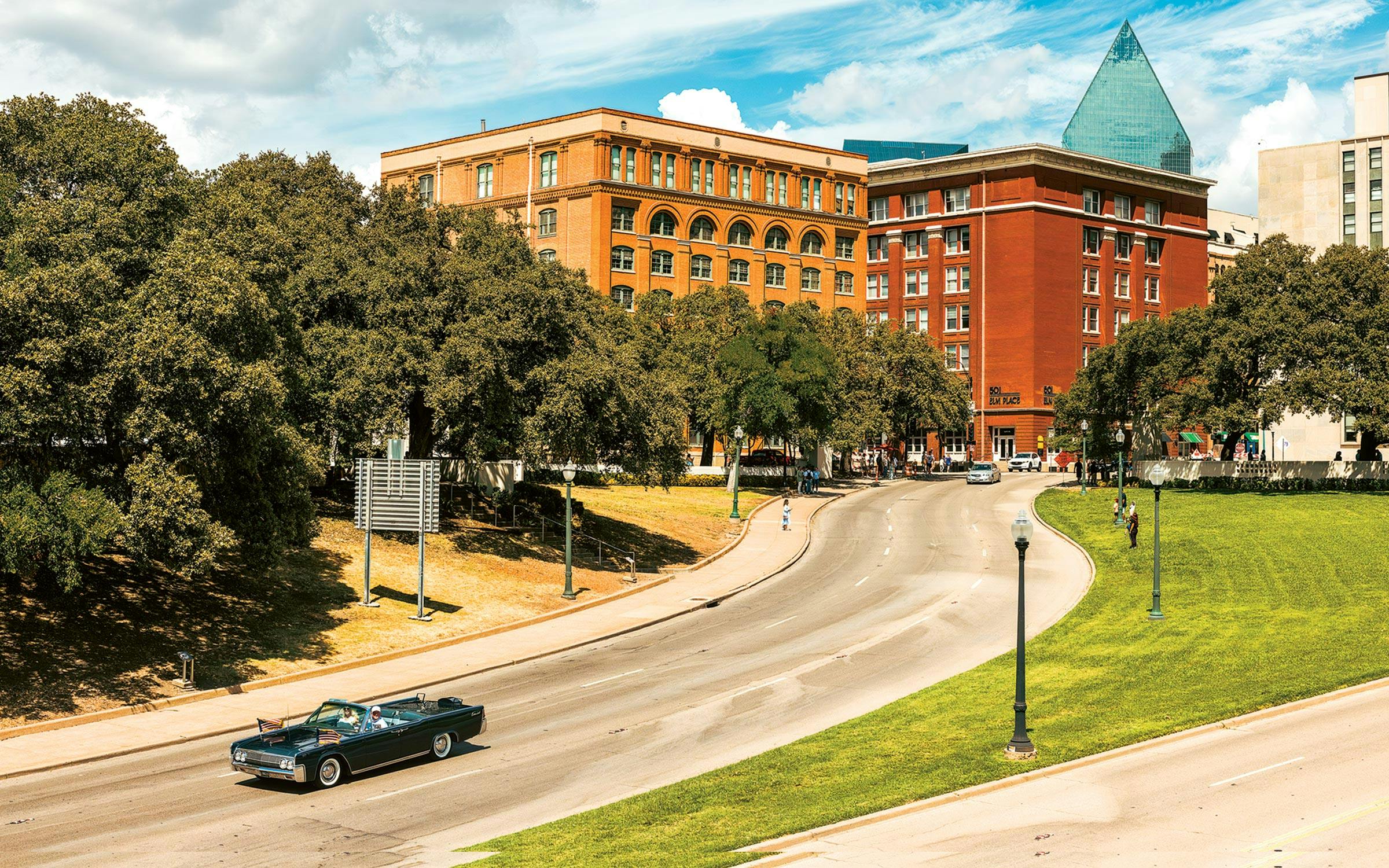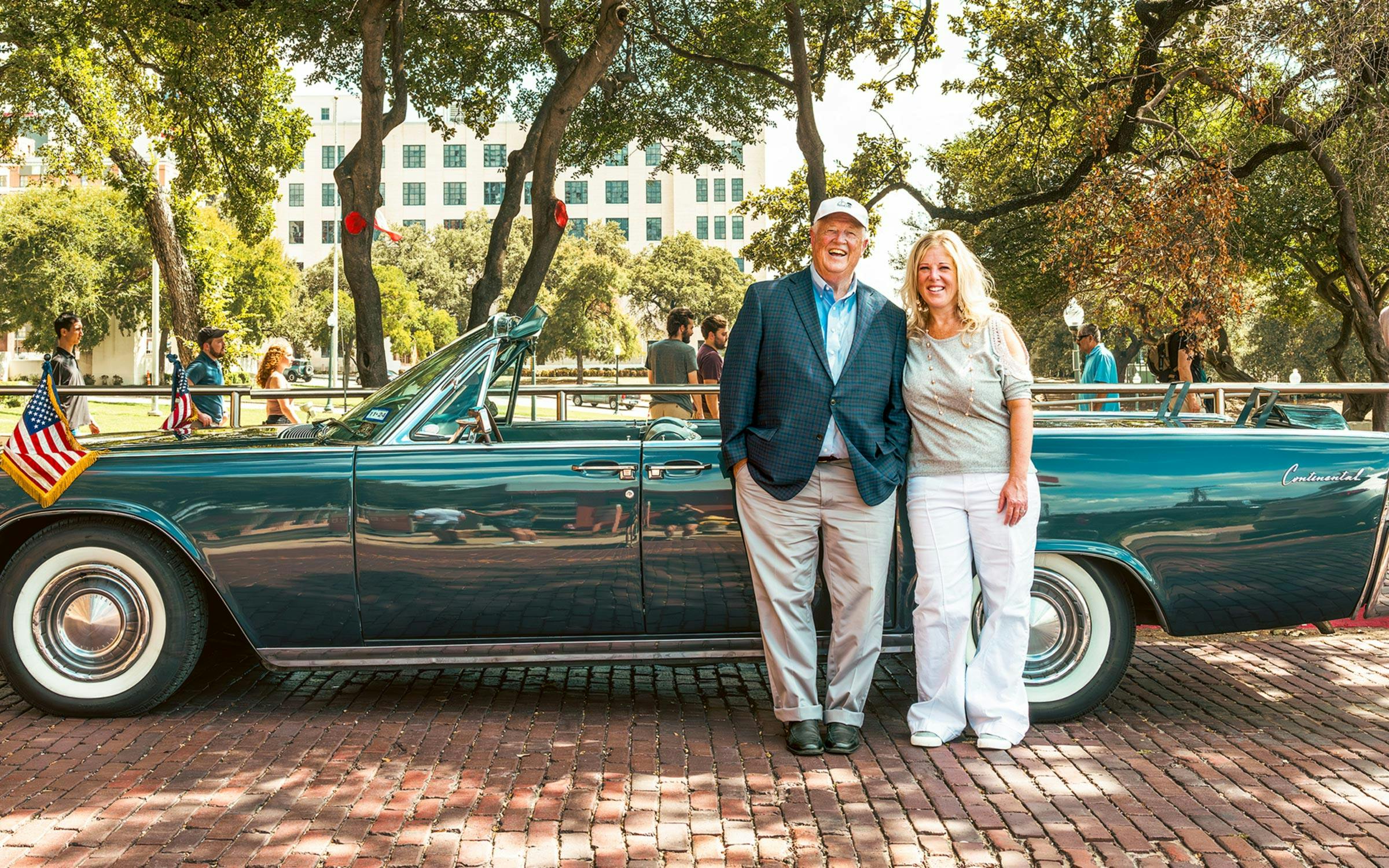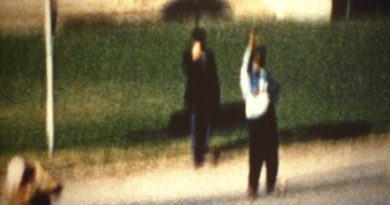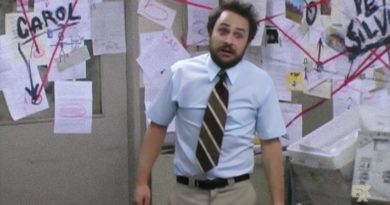Inside Dallas’s Eight-Hour, $800 JFK Assassination Tour

Photograph by Wynn Myers
Inside Dallas’s Eight-Hour, $800 JFK Assassination Tour
A funeral home director channels his obsession with what happened in November 1963 into an all-day odyssey, complete with a convertible ride down Elm Street.
I’m sitting in the back seat of a midnight blue Lincoln Continental convertible that looks almost identical to the one that carried John F. Kennedy on November 22, 1963. Two U.S. flags on the hood flutter in the wind as we cruise through downtown Dallas. This meticulously restored 1963 model even features blankets emblazoned with the presidential seal. As we turn left onto Elm Street from Houston Street, my guide, Robin Brown, slows to 14 miles per hour, close to the speed Kennedy’s motorcade traveled along this route.
More than sixty years have passed since the assassination, but I still find myself holding my breath as we roll over the first hand-painted X on the pavement marking where the initial shot struck. By the second X, I’m feeling surprisingly tense. Brown locks eyes with me in the rearview mirror as we accelerate under the triple underpass at the edge of Dealey Plaza.
“Once you’re in this,” he says with a smile, “there’s no turning back.”
Dallas offers many ways to learn about the JFK assassination: Segway tours; hop-on, hop-off trolleys; golf-cart-like electric Cruizer cars; and the JFK Food and Culture walking tour. About 350,000 visitors come to the Sixth Floor Museum, in the former Texas School Book Depository, each year. The sustained fascination with what happened that day has been fed by conspiracy books, Broadway musicals, and TikTok videos. A 2023 Gallup poll found that 65 percent of Americans believe that Lee Harvey Oswald could not have acted alone when he shot Kennedy and wounded Texas Governor John Connally, a 4 percent increase from a decade earlier.
Emily Williams, the marketing manager at the Sixth Floor Museum, says many millennials like her—and me— are just as interested as their parents: “About sixty percent of visitors to the museum were born after 1963.” She grew up hearing tales from her family; her great-grandfather, Marvin Johnson, was a Dallas police detective who was on the scene that day.
What fuels this enduring obsession? Is it a deep-seated mistrust of the government, society’s love of conspiracy theories, or the question of how our world would look today had Kennedy survived?
According to Robin Brown, the answer is all of the above. Through his company, JFK Custom Tours, he offers five tours of varying lengths. About half his clients spring for the longest and most expensive option: the Presidential Tour, a $100-an-hour, all-day odyssey. You can choose from various add-ons, including “Retrace the motorcade’s frantic rush to Parkland Hospital” and “Visit the graves of JFK witnesses.”


Brown, now seventy years old, started his business in 2014 at the urging of his daughter Kendal, who created his website and handles his bookings. “She saved my marriage,” he says, chuckling. “The tour puts me in front of people who want to listen to me. My wife is very happy I’m with you right now and not her.” By day, Brown runs the Geo J. Carroll & Son Funeral Home, in Gainesville, about seventy miles north of Dallas. He now delegates many of his daily duties to his son and other employees so that he can give more tours. Brown is a sought-after resource on the Kennedy assassination who has been featured in Netflix’s Dark Tourist series and Brad Metzler’s book, The 10 Greatest Conspiracies of All Time.
I figured an $800, eight-hour solo tour would at least provide me with some new angles on the subject—at a time when more and more people question the government’s account of the assassination.
The night I arrived in Dallas from Austin, I researched the average time commitment for visiting Dealey Plaza: ten minutes. I wondered how Brown could fill eight hours on an event that happened more than sixty years ago. The next morning, I would find out.
9 a.m. Dealey Plaza
I meet Brown at the famous grassy knoll within the plaza. It’s already 92 degrees, yet he’s wearing a crisp navy blue suit; a U.S. flag is pinned to his lapel. His opening line: “I will not say ‘we suspect’ during this tour. I know what happened.”
Suddenly he leaps into oncoming traffic to stand on the crudely painted X marking the first shot. Every few years, the City of Dallas paves over the two X’s, but it never takes long for someone to paint them back. Drivers honk at Brown to move out of the way, but he doesn’t budge. He gestures for me to join him and points at the infamous book depository’s sixth-floor window, which is obstructed by leaves. He tells me he disagrees with the government’s contention that, because the trees were bare that day, Oswald had a clear shot from the window. “Texas live oak trees shed their leaves in the spring, not the winter.” He throws his hands on his cheeks for emphasis. “Think about it!” (Others say the trees were several feet shorter sixty years ago, giving Oswald a clear shot regardless of any foliage.)
Brown was just nine years old in November 1963, and by nineteen he had immersed himself in researching the case. Over the past fifty years, he has investigated every aspect, he says. We spend almost three hours going over the minutiae of that day. I stand on the concrete pedestal where clothing manufacturer Abraham Zapruder filmed the assassination with his 8-millimeter camera. (A few months after my tour, newly discovered footage by another Dallas businessman of the moments right after the shots sold for nearly $138,000 at auction.)
As it nears noon, we head toward Brown’s Continental, parked by the Sixth Floor Museum, which wasn’t included in the tour. A swarm of visitors are taking selfies with the car. “I have to wait in line to get in my car,” he tells me. “I enjoy that.”


1 p.m. Oak Cliff
We eat lunch at Oddfellows, a popular spot in the Bishop Arts neighborhood. I anticipate a respite from the tour and the chance to ask Brown about his life outside of JFK. But I should have known better.
He immediately delves into the details of the Zapruder film, claiming to have watched it seven thousand times. When his sandwich arrives, he unfolds his napkin and holds it up to his face. “I hate talking with my mouth full,” he explains as he speaks frantically about the film from behind his paper shield.
2 p.m. 1026 North Beckley Avenue
We return to the car. Brown tosses his rumpled jacket on the seat next to him and chugs water from a giant Chick-fil-A cup. Giving this tour is an act of endurance. An extra suit hangs neatly in the back. We pull up to the modest boarding house where Oswald rented a room at the time of the assassination.
It’s now the Oswald Rooming House Museum, run by Patricia Hall, the granddaughter of the woman who owned the home in 1963. His tour doesn’t include a visit inside. “There’s still too much more to see,” he explains.
3 p.m. Tenth and Patton streets
Brown takes us to the corner where Oswald shot and killed 39-year-old Dallas patrolman J. D. Tippit less than an hour after Kennedy was gunned down. As we drive, he references a favorite book of his, conspiracy theorist James W. Douglass’s 544-page tome, JFK and the Unspeakable: Why He Died and Why It Matters.
We step out of the car, passing a group of young tennis players on high school courts, and view the Texas Historical Commission plaque honoring the fallen officer.
Brown’s phone rings, and he answers. I overhear his wife asking where he is: “I’m at the Tippit murder scene.” I think I hear her sigh loudly before Brown hangs up. When the call ends, he picks up where he left off, discussing witness testimonies.
4 p.m. Texas Theatre
Next we head to the 1931 movie house where police apprehended Oswald, who had slipped in during a matinee showing of War Is Hell. The entrance is roped off for a private event, but Brown charges through: “We’re getting in there,” he assures me with a wink.
A manager asks why we’re there. I explain that I’m on a JFK tour. He closes his eyes—this has happened before, I gather. Brown speed walks right into the theater. As we are corralled out, Brown calls my attention to the chair Oswald sat in that day: “Three rows from the back, five seats from the aisle.”
After my tour, I’ll talk to Vianca Vega, who runs the theater’s box office. “Every day, as soon as we open our doors, at least one person rushes in to see Oswald’s chair. If we’re not screening a movie, I let them explore for a few minutes. Sometimes, they’ll buy a T-shirt or popcorn, which is good business.”


5 p.m. Old City Hall
Our final stop is outside the beaux arts–style building that in 1963 housed Dallas Police Headquarters, where Jack Ruby shot Oswald two days after JFK’s assassination.
The tour comes to a close as we descend the limestone steps. I feel a strange combination of delight, frustration, curiosity, and
melancholy. Today I’ve been thrown out of a movie theater, bombarded with facts about the physics of flying bullets, and nearly flattened by a semitruck on Elm Street. I’ve covered more than 25 miles, made ten stops, and absorbed countless facts.
I might not understand everything that happened in November 1963, but, after the tour, I now understand why so many people—from the tourists who stroll through Dealey Plaza every day to a charismatic funeral director with a morbid side hustle—still care so much.
This article originally appeared in the November 2024 issue of Texas Monthly with the title “My Day as a Conspiracy Tourist.” Subscribe today.
- More About:
- JFK Assassination
- JFK
- Dallas
![New doc ‘JFK: What the Doctors Saw’ shows that assassination conspiracy theories continue to rage, 60 years later [Watch The Trailer] - IMDb](https://conspiracyresource.com/wp-content/uploads/2024/03/new-doc-jfk-what-the-doctors-saw-shows-that-assassination-conspiracy-theories-continue-to-rage-60-years-later-watch-the-trailer-imdb-390x205.png)

